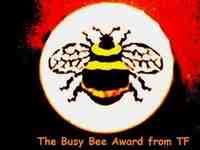
Another picture of the stunning trees I saw yesterday. It's a little easier to see in this one that the colour is provided by berries, there are few leaves on the trees. I'm hoping they're Rowan trees, because Rowan's have an very interesting heritage:
They are mentioned in Greek history, in the story of Hebe. She loses her magical chalice to demons and it is retrieved by an eagle, who sheds blood during the fight with the demons. These drops of blood turned into Rowan trees. It was said that a Rowan tree has feather-shaped leaves in honour of the eagle. (I'm not sure the leaves of the trees I saw were shaped like feathers, but it's difficult to say at this time of year.)
In Norse mythology, the first woman was made from a Rowan tree (the first man was made from an Ash tree.) And a Rowan tree saved the life of Thor, helping him to escape the river sweeping him into the underworld. Rowan has traditionally been used as the material for rune staves. Something I've learnt today: 'Every runic letter is called a stave, not a rune stone; the only rune stones are the large runic monuments in Sweden or the Ruthwell cross in southern Scotland and other such monuments.' (This is from a great article in The Spiral: http://www.thespiral.co.uk/current_issue/runetree.htm)
Celtic folklore encouraged the use of Rowan trees as protection against witchcraft, perhaps due to the tiny five-pointed star or pentagram on each of its berries. (I do think the trees I saw had these!) 'The rowan was also denoted as a tree of the Goddess or a Faerie tree by virtue (like the hawthorn and elder) of its white flowers.'
Rowan is a very useful tree. 'It is strong and resilient, making excellent walking sticks and tool handles. Spindles and spinning wheels were traditionally made from Rowan wood. The Druids used the bark and berries to dye their garments worn during lunar ceremonies black, and the bark was also used in the tanning process. Rowan twigs were used for divining, particularly for metals.' (From the very interesting Trees For Life website: http://www.treesforlife.org.uk/forest/mythfolk/rowan.html)
The berries have been used to make a variety of alcoholic drinks, including wines, a strong spirit, a Welsh ale, some ciders and it was used to flavour Irish mead. Today Rowan Berry Jelly is still made in Scotland and is traditionally eaten with game.
'The Rowan, sorbus aucuparia, Mountain Ash, or Quickbeam, has the ability, perhaps more than any other tree, to help us increase our psychic abilities and connections. It has a beneficial energy which will increase our abilities to receive visions and insights which in turn will increase our communication with the spirit realms. In the past it was valued as a protection against enchantment, unwanted influences and evil spirits. Sprigs of Rowan were placed over doorways and fixed to cattle sheds to protect the animals from harm. Similarly, farmers would drive their sheep through hoops of Rowan branches, and in Wales Rowan trees were planted in churchyards to watch over and protect the spirits of the dead.' For more on this see Glennie Kindred's article on The Tree of Imbolc: http://www.whitedragon.org.uk/articles/rowan.htm
Fascinating trees then, Rowan trees.
But having said all that ... those I saw yesterday might be Hawthorn trees!
I have found it hard to distinguish them in a brief online trawl this morning. Does any else know the difference?






No comments:
Post a Comment